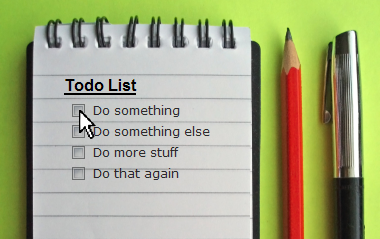 I’ve tried a lot of task management systems and to-do list apps over the years. Simple and complex, web-based and native, mobile and desktop. Despite some of them being quite slick, I always ended up ignoring them over time. It seems stupid, but just the fact that my tasks are on some separate app that I have to consciously open and keep updated, makes me drop them eventually. It is “too much work”. Eventually I found a workflow that’s so integrated into my daily routine that it works perfectly for me. Everyone’s different, but I’m sure some people will find it works wonderfully for them too.
I’ve tried a lot of task management systems and to-do list apps over the years. Simple and complex, web-based and native, mobile and desktop. Despite some of them being quite slick, I always ended up ignoring them over time. It seems stupid, but just the fact that my tasks are on some separate app that I have to consciously open and keep updated, makes me drop them eventually. It is “too much work”. Eventually I found a workflow that’s so integrated into my daily routine that it works perfectly for me. Everyone’s different, but I’m sure some people will find it works wonderfully for them too.
Before I go any further let me clarify something. Besides the system I’ll describe in this post, I also use Basecamp, where I have all my projects and their respective backlog of tasks (plus documents, etc). Some of those lists are huge, some are small. It depends on the project. I usually have a vague roadmap of big projects and features (launch X on Q2 2014, etc), but other than that I just have a week or two worth of tasks planned (with deadlines). And I mostly use the calendar to have a visual view of my next weeks’ worth of work.
So I do use some classic project management software. The system I’m about to describe works on top of that. I use it for emails I need to reply, personal tasks (do laundry, call someone, do taxes, etc), work related tasks that don’t necesarily fit into a Basecamp project (or I just feel like it’s important enough to deserve extra visibility), or maybe it’s something I thought about and haven’t had the time to put into Basecamp yet.
Keeping Your Tasks Visible
Something everyone has problems with is finding a way to be aware of their to-do items. Some people try sticking post-it notes on the bathroom mirror or the computer monitor, since they think they’ll look at them every day. I don’t think that’s a useful method, since there’s limited real state available and is harder to maintain than an digital solution.
At some point I realized there is something that I look at multiple times during the day, every day. Even in my off days. My inbox. I always have a Gmail tab open. Or if I’m on the go, check it on my phone quite often.
Using Your Inbox As A To-Do List
There are some people who may receive hundreds of emails a day they need to reply to, and they’ll think they can’t make this work because of the volume. I personally receive maybe around 100 emails a day, sometimes more, although a lot of them are things that I need to know about, but not necessarily need to reply to. My opinion is that this system works whatever your email volume is.
The way the system works is very simple, really: each email you receive is something you need to act upon, and you use email for everything. For every email you receive, these are your choices:
- You can do nothing (that’s also a choice) if you don’t have to do anything about it. Maybe you were just CC’d on something but your whole purpose on that thread is to know about it. This means you just read it (or mark it as read).
- You can delete or archive it, if it’s completely useless or you don’t particularly want it wasting space in your inbox. Keep in mind that I don’t strive for inbox zero in the traditional sense. For me, an unread item is an item that requires my attention. A read item is one I already dealt with. So for me, zero unread items is the equivalent of inbox zero.
- You can reply to it.
- You can delegate it to someone (forward it or CC someone into the conversation).
- You can postpone it (maybe it’s something you need to deal with but only in, say, a week from now, and you don’t want it bothering you now).
- You can create a task into your formal task management software (if you use any). This includes Basecamp, Jira, FogBugz, Flow, Asana, etc.
- You can take some other action (maybe call someone, run an errand, etc).
How It All Actually Works
The technical implementation of this system is pretty straightforward:
- Use Gmail in your desktop, configured to show “Unread Messages First”. This effectively separates your inbox in two: first all your unread emails, which are all the items on your to-do list that you haven’t dealt with, and then all your read messages, which could be thousands or more, it doesn’t matter, and you shouldn’t really look at them unless you need to dig up some old data (a flight’s details, an old conversation, etc). In essence, you should only be focusing on the unread items in your inbox.
- If you for example read an email and you need to do something with it (like reply) but can’t do it right away, just mark is as unread and you’ll keep seeing it at the top of your inbox, and you’ll never forget to reply.
- Adding a task to your list is as simple as sending yourself an email. From any device in the world, really. In the desktop, I just send myself an email from Gmail since with autocomplete it takes 2 seconds. On my phone, which I use several times per day when I need to remind myself of anything, I use Captio. A 1.99$ app which I use several times per day. Easily best two bucks I ever spent. Just fire it up, write whatever you want to send yourself, and then click Send. You can even attach images and files. Way faster than using the Email app.
- I wish there was a way I could easily reorganize my unread emails in Gmail and they stayed that way, to reprioritize tasks (keep most important tasks on top instead of latest). But what I do works most of the times: I just reply to it (assuming I sent it to myself), or just forward it to myself. That way it goes to the top of the list. I don’t necesarily take action on items from top to bottom, but I find that sometimes an item I’ve been procrastinating about for a while and has been sitting at the bottom of the list gets more attention from me if I bump it to the top.
- I use the Gmail iPhone app since it has a “Show unread emails first” and the official iPhone Mail app does not. It’s a pity because other than that, I prefer the official app.
- To postpone a task, or be reminded some time in the future, I use FollowUp.cc. It’s a great service, and quite cheap (I actually used the free version for months until I needed more monthly emails). You basically send an email to an address like [time]@followup.cc, and you’ll get a reminder after that time. For example: 1w@followup.cc will send you that email back to you after 1 week. 3d@followup.cc will send it to you after 3 days. And so on. The paid version even has a calendar you can look at and it’ll show all your scheduled reminders. It’d be awesome if you could reschedule them by drag and dropping them, again like tasks on Basecamp.
- For exact time and date reminders (like you have a Skype call next Monday at 2pm, or a doctor’s appointment), I personally prefer to use my phone’s calendar system (although you could always use Google Calendar and have it synced to your phone), and I always include two alerts. One quite some time in advance, the other with very little margin. It depends on the situation, for example:
- For a Skype call, I’ll probably have one an hour before, and then 5 minutes before.
- For a doctor’s appointment at 9am, I might have one the day before and the other an hour before, since I’ll need to physically go somewhere for it.
- I also use labels in Gmail to quickly differentiate tasks at a glance. For example, any emails I receive from myself are labeled as TO-DO. If they’ve been sent to one of my businesses’ address, I label them as from that business. I use strong colors with white text (like bright red or blue) for work or more important projects, and lighter colors with dark text for personal stuff.
How Does My Inbox Usually Look Like?
Usually, when I look at my inbox in the morning it has anywhere from 50 to 100 unread messages. After I’ve deleted all the notifications, dealt with the easy stuff and replied to the quick emails, I’m down to less than 20.
Those 20 are usually a variety of things, which can include:
- An email that will take some concentration and time to reply to.
- An email that will require that I perform some other task before I can reply to.
- A reminder that I need to run some errand (do laundry, buy groceries, etc) or task (change copy, fix bug, etc).
- Some ideas for features or projects that I need to either do (maybe it’s a possible solution for a bug I’m trying to fix) or just dump into Basecamp (if it’s more of a complex task that will require breaking it into smaller tasks).
- A link to a blog post, article, ebook, video or any other type of resource I found while browsing the net (probably on my phone) and I want to take the time to look into at some point. Usually these end up either being read/watched in a week’s time or I deem them not that important after all, and just mark them as read.
At this point, and depending on how motivated I am, I start by the easiest or hardest/most important, and use the momentum to plow through as many as I can before I call it a day (or move on to my tasks for the day on Basecamp).
I’d love to hear your feedback on my system as well as any recommendations to improve it or make it even simpler to use.

Pingback: Lessons Learned After Working From Home For 4 Years | Manuel F. Lara's blog